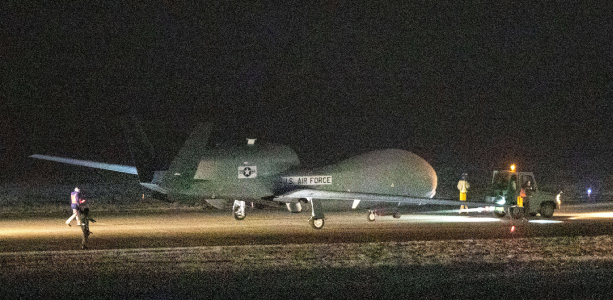Seoul takes delivery of drone at crack of dawn

South Korea receives its first RQ-4 Global Hawk unmanned aerial vehicle at an Air Force base in Sacheon, South Gyeongsang, early Monday morning. [YONHAP]
The high-altitude RQ-4 Block 30 Global Hawk drone, built by U.S. defense manufacturer Northrop Grumman, arrived at an Air Force base in Sacheon, South Gyeongsang, at around 5 a.m. - the first of four such aircraft Seoul acquired in an approximately $1.2-billion deal.
Seoul’s earliest attempt to acquire the drone from the United States took place in 2003 - when North Korea was in the early stages of its nuclear development program - and it was only in 2014 that the acquisition was finally approved by Washington. While the unmanned aerial vehicle (UAV) was expected to be delivered by early 2018, the United States delayed the transfer owing to cybersecurity issues. Then errors with the drones’ radar and electro-optical or infrared sensors caused further delays this year.
“The [RQ-4] was delayed because of the rigorous testing we undertook in the United States to reach perfect operability,” said a military source. “But there were prevailing opinions in the government that, given the current situation on the Korean Peninsula, the arrival of the first UAV must not be delayed until the following year.”
The other three RQ-4 drones are set to arrive within the first half of next year, though no definite schedule has been set, according to the Air Force.
Global Hawk is one of the most expensive and sophisticated unmanned aerial surveillance systems currently in use, equipped with a high resolution imaging devices and radar that enable it to detect objects as small as 30 centimeters (11.8 inches) from an altitude of 20 kilometers (12.4 miles). From such an altitude, the drone can operate between 38 to 42 hours and survey a distance of up to 3,000 kilometers, putting most of Northeast Asia within range of its surveillance capabilities even when it is in South Korean airspace.
With the acquisition of the RQ-4, Seoul will now be able to independently obtain important aerial reconnaissance data from the North Korean interior that it has relied on Washington to provide. Aerial spy planes South Korea currently operates are limited to South Korean airspace, so their visibility does not extend to areas north of Pyongyang, which left key nuclear and missile sites like the Yongbyon nuclear complex or Tongchang-ri launching site out of range.
Separate from the introduction of the Global Hawk into its military, Seoul is also pursuing the development of its own homegrown mid-altitude unmanned aerial vehicle, tentatively known as the KUS-15. Primarily developed by Seoul’s Agency for Defense Development (ADD) and Korean Air’s aerospace division, the idea was first conceived in 2008, and around 488.4 billion won has been invested in the project for an estimated completion by the early 2020s.
The arrival of the RQ-4 to South Korea comes at a particularly sensitive time on the peninsula ahead of a possible provocation teased by the North as a “Christmas gift” for the United States. Seoul’s decision not to make a public announcement about the arrival of the Global Hawk may be seen as an attempt to avoid antagonizing Pyongyang, which strongly objects to the South’s acquisition of new armaments, like its recent deployment of F-35A jets, from the United States.
What form of provocation from the North will take remains a matter of speculation, but it is widely believed North Korean leader Kim Jong-un will announce a major policy shift at a plenary meeting of the country’s ruling Workers’ Party with the expiration of Pyongyang’s self-imposed deadline of the end of the year for progress in denuclearization negotiations with Washington. While many experts in South Korea say a long-range or intercontinental ballistic missile (ICBM) test is unlikely due to the harsh consequences of what it would provoke, there have been signs recently that the North is advancing its missile program, particularly with two tests earlier this month that are believed to have involved rocket engines.
On Saturday, Jeffrey Lewis, director of the East Asia Nonproliferation Program at the Middlebury Institute, posted to his Twitter account satellite images showing the North is building a temporary structure at the March 16 Factory in Pyongsong, South Pyongan Province, “which is involved in the development and production of ICBM launchers.” Lewis told NBC that the structure is located next to the building where Kim watched a test launch of the Hwasong-15, the regime’s largest ICBM that can reportedly reach the continental United States.
Seoul and Washington appear to be preparing for the worst, while scaling up monitoring of the North.
According to Aircraft Spots, a Twitter handle that tracks military aircraft worldwide, a U.S. Air Force RC-135W surveillance plane flew approximately 31,000 feet above the Korean Peninsula on Monday in the latest of a string of such flybys in recent weeks.
Perhaps as a warning to Pyongyang, the U.S. Department of Defense on Monday released photos of South Korean and U.S. special forces conducting various exercises throughout August to November that appeared to include a simulation of a raid on a North Korean military base and capture of enemy personnel.
BY SHIM KYU-SEOK, LEE CHUL-JAE [shim.kyuseok@joongang.co.kr]










with the Korea JoongAng Daily
To write comments, please log in to one of the accounts.
Standards Board Policy (0/250자)